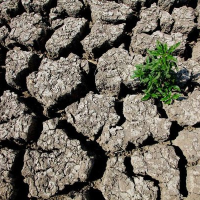Fracking Companies Clash with Grain Shippers and Army Corps of Engineers over Use of Missouri River Water
 Mississippi River (photo: Robert Ray, AP)
Mississippi River (photo: Robert Ray, AP)
The continuing drought of 2012—which has created abnormally dry conditions over 80% of the contiguous U.S.—may soon prevent barge traffic from navigating the critical 180-mile stretch of the Mississippi River between the confluences of the Missouri River near St. Louis and the Ohio River at Cairo, Ill., along which river depth is 15 to 20 feet less than normal. At the same time, oil companies conducting fracking operations in North Dakota are demanding immense quantities of Missouri River water be diverted to them, further threatening levels on the Mississippi.
Experts predict the river could close to barges in mid-December and remain that way for two months, just as the harvest heads to market via river barges, and fertilizer shipments head north. According to the trade group American Waterways Operators, closing the Middle Mississippi for the next two months would impede the transport of $7 billion worth of products including 7 million tons of agricultural products worth $2.3 billion; 1.7 million tons of chemical products worth $1.8 billion; 1.3 million tons of petroleum products worth $1.3 billion; 700,000 tons of crude oil worth $534 million; and 3.8 million tons of coal worth $192 million. Finding alternative transportation will be costly, with consumers eventually footing the bill.
To make matters worse, last week the U.S. Army Corps of Engineers began reducing the outflow from a Missouri River dam in South Dakota, intending to cut the flow at least two-thirds by December 11 as a way to ease the local effects of the drought. Absent a freak hurricane over the northern Mississippi River valley, that reduction in water flow will ensure a closure of the Middle Mississippi. Given the economic impact, legislators from Mississippi River states are angry over the Corps’ action and even asked the White House for a presidential emergency declaration to overturn it, which so far has not occurred.
Meanwhile, North Dakota’s leaders are only too eager to divert Missouri River reservoirs to the state’s oil fracking boom, which requires hundreds of millions of gallons of water. North Dakota Gov. Jack Dalrymple (R) has stated that he will oppose any Corps plan that would restrict oil companies from using that water.
-Matt Bewig
To Learn More:
River vs. River: Corps Manages Missouri, Mississippi Rivers for Conflicting Goals (editorial, Quad City Times)
Mississippi River Traffic in Trouble (by Joe Harris, Courthouse News Service)
Despite Protests, Warnings River Flows Slowed (Farm Futures)
Mississippi River could become impassable in two weeks (by Scott Wuerz, Belleville News-Democrat)
Every U.S. State Now Hit by Drought Conditions (by Noel Brinkerhoff, AllGov)
- Top Stories
- Unusual News
- Where is the Money Going?
- Controversies
- U.S. and the World
- Appointments and Resignations
- Latest News
- Musk and Trump Fire Members of Congress
- Trump Calls for Violent Street Demonstrations Against Himself
- Trump Changes Name of Republican Party
- The 2024 Election By the Numbers
- Bashar al-Assad—The Fall of a Rabid AntiSemite






Comments